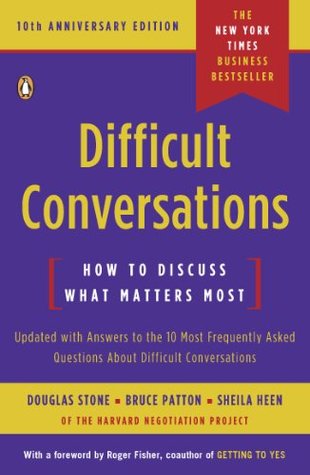More on this book
Community
Kindle Notes & Highlights
Read between
August 21 - September 25, 2022
shift from a “message delivery stance” to a “learning stance.”
The “What Happened?” Conversation is where we spend much of our time in difficult conversations as we struggle with our different stories about who’s right, who meant what, and who’s to blame.
The point is this: difficult conversations are almost never about getting the facts right. They are about conflicting perceptions, interpretations, and values.
Interpretations and judgments are important to explore. In contrast, the quest to determine who is right and who is wrong is a dead end.
The error we make in the realm of intentions is simple but profound : we assume we know the intentions of others when we don’t. Worse still, when we are unsure about someone’s intentions, we too often decide they are bad.
it produces disagreement, denial, and little learning. It evokes fears of punishment and insists on an either/or answer. Nobody wants to be blamed, especially unfairly, so our energy goes into defending ourselves.
Talking about blame distracts us from exploring why things went wrong and how we might correct them going forward. Focusing instead on understanding the contribution system allows us to learn about the real causes of the problem, and to work on correcting them.
The Feelings Conversation: What Should We Do with Our Emotions?
Feelings are not some noisy byproduct of engaging in difficult talk, they are an integral part of the conflict.
The Identity Conversation: What Does This Say About Me?
Why is it always the other person who is naive or selfish or irrational or controlling?
We Each Make Sense in Our Story of What Happened
Arguing inhibits our ability to learn how the other person sees the world.
Why We Each See the World Differently
1. We Have Different Information
We Each Know Ourselves Better Than Anyone Else Can.
2. We Have Different Interpretations
we interpret what we see are (1) our past experiences and (2) the implicit rules we’ve learned about how things should and should not be done.
Our Conclusions Reflect Self-Interest
Move from Certainty to Curiosity
Embrace Both Stories: Adopt the “And Stance”
“And” helps you to be curious and clear.
Before you can figure out how to move forward, you need to understand where you are.
Our Assumptions About Intentions Are Often Wrong
we make an attribution about another person’s intentions based on the impact of their actions on us.
When we think others have bad intentions toward us, it affects our behavior. And, in turn, how we behave affects how they treat us. Before we know it, our assumption that they have bad intentions toward us has come true.
Good Intentions Don’t Sanitize Bad Impact
Disentangle Impact and Intent
1. Actions: “What did the other person actually say or do?” 2. Impact: “What was the impact of this on me?” 3. Assumption: “Based on this impact, what assumption am I making about what the other person intended?”
Share the Impact on You; Inquire About Their Intentions.
Listen Past the Accusation for the Feelings.
Focusing on blame is a bad idea because it inhibits our ability to learn what’s really causing the problem and to do anything meaningful to correct it.
blame is about judging and contribution is about understanding.
Blame Is About Judging, and Looks Backward
Contribution Is About Understanding, and Looks Forward
when things go wrong in human relationships, everyone has contributed in some important way.
When Blame Is the Goal, Understanding Is the Casualty
Focusing on Blame Hinders Problem-Solving
Blame Can Leave a Bad System Undiscovered
You can be 5 percent responsible or 95 percent responsible — there is still joint contribution.
Tools for Spotting Contribution
Role Reversal
The Observer’s Insight
we frame the problem exclusively as a substantive disagreement and believe that if only we were more skilled at problem-solving, we’d be able to lick the thing. Solving problems seems easier than talking about emotions. Framing feelings out of the problem is one way we cope with the dilemma of whether to raise something or avoid it. The potential costs involved in sharing feelings makes raising them feel like too big a gamble.
unexpressed feelings can create so much tension that you disengage:
Unexpressed Feelings Take a Toll on Our Self-Esteem and Relationships
When you are more concerned about others’ feelings than your own, you teach others to ignore your feelings too.
Landscape of Sometimes Hard-to-Find Feelings Love Affectionate, caring, close, proud, passionate Anger Frustrated, exasperated, enraged, indignant Hurt Let down, betrayed, disappointed, needy Shame Embarrassed, guilty, regretful, humiliated, self-loathing Fear Anxious, terrified, worried, obsessed, suspicious Self-Doubt Inadequate, unworthy, inept, unmotivated Joy Happy, enthusiastic, full, elated, content Sadness Bereft, wistful, joyless, depressed Jealousy Envious, selfish, covetous, anguished, yearning Gratitude Appreciative, thankful, relieved, admiring Loneliness Desolate, abandoned,
...more
we need to examine our own story. What is the story we are telling ourselves that is giving rise to how we feel?
we need to explore our assumptions about the other person’s intentions. To what extent are our feelings based on an untested assumption about their intentions?


